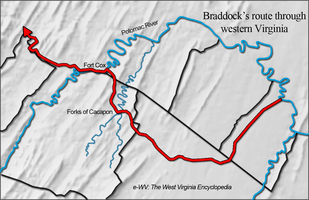 | Back to e-WV
| Back to e-WV
 The West Virginia Encyclopedia
The West Virginia Encyclopedia
 | Back to e-WV
| Back to e-WV
 The West Virginia Encyclopedia
The West Virginia Encyclopedia

Braddock’s Road traces the path of Maj. Gen. Edward Braddock, commander of British forces in the colonies, on his disastrous march to the Ohio Valley during the French and Indian War. In the spring of 1755, Braddock assembled an army of about 2,400 British regulars and colonial militia to attempt to force the French from Fort Duquesne, at present Pittsburgh.
Braddock’s Road crosses what is now West Virginia’s Eastern Panhandle. In order to move and supply his army, Braddock improved existing roads in present Jefferson, Berkeley, and Hampshire counties. Young George Washington, having traveled much of the same route the previous year when his own forces were defeated at Fort Necessity, Pennsylvania, served as an aide-de-camp to Braddock.
The army crossed some of the roughest terrain on the entire route in present West Virginia, as they traveled from Fort Enoch near Forks of Cacapon to the Potomac River ford at Fort Cox, about two miles west of Paw Paw. The soldiers crossed one mountain stream 19 times and another 20 times as they made their way over Spring Gap Mountain, Hampshire County.
Braddock was killed in fierce fighting before reaching Fort Duquesne, and the defeated army returned over the same route. Although Braddock’s Road was abandoned years ago, traces of it can still be seen along various Eastern Panhandle county roads.
Written by Tommy Swaim
Ansel, William H. Jr. Frontier Forts Along the Potomac and its Tributaries. Parsons: McClain, 1984.
Hough, Walter. Braddock's Route through the Virginia Colony. Winchester, VA: Winchester-Frederick County Historical Society, 1970.